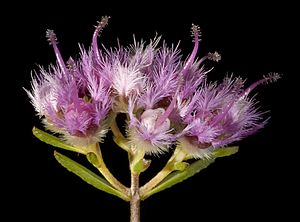Verticordia densiflora var. densiflora facts for kids
Quick facts for kids Verticordia densiflora var. densiflora |
|
|---|---|
 |
|
| Scientific classification |
|
| Kingdom: | Plantae |
| Clade: | Tracheophytes |
| Clade: | Angiosperms |
| Clade: | Eudicots |
| Clade: | Rosids |
| Order: | Myrtales |
| Family: | Myrtaceae |
| Genus: | Verticordia |
| Species: | |
| Varietas: |
V. d. var. densiflora
|
| Trinomial name | |
| Verticordia densiflora var. densiflora |
|
Verticordia densiflora var. densiflora is a beautiful flowering plant. It belongs to the myrtle family, called Myrtaceae. This plant only grows naturally in the south-west part of Western Australia. It is a type of shrub with small leaves. Its flowers are usually pink, but sometimes they can be white. This plant is one of five different kinds of the species called Verticordia densiflora.
Contents
What Does This Plant Look Like?
Verticordia densiflora var. densiflora is a shrub with branches that spread out. It can grow to be about 0.15–1.0 m (0.5–3 ft) tall. The leaves on this plant can be different shapes. Some are long and thin (linear), while others are shaped like an egg. The leaves near the flowers are about 0.8–1.3 mm (0.03–0.05 in) wide.
The flowers of this plant have a nice smell. They grow in groups that look like flat-topped clusters (called corymbs). Each flower sits on a straight stalk that is about 1.5 to 2.5 mm (0.06 to 0.1 in) long. The base of the flower (called the floral cup or hypanthium) is shaped like half a ball. It is about 1.5 mm (0.06 in) long and feels smooth, but it has some hairs near its bottom.
The outer parts of the flower (called sepals) are usually pale pink. They can also be a very dark purplish-pink. As they get older, their color might fade. Sometimes, they are even white. These sepals are about 2–3.5 mm (0.08–0.1 in) long. They have three parts (lobes) with rough hairs along their edges. The inner parts of the flower (called petals) are similar in color to the sepals. They are about 0.8–1.9 mm (0.03–0.07 in) long and egg-shaped. Their ends have many small threads or filaments. The part of the flower that collects pollen (the style) is about 5–6 mm (0.20–0.24 in) long. It sticks out past the petals and is curved and hairy. This plant usually blooms from September to February.
How It Got Its Name
The plant Verticordia densiflora was first officially described by a person named John Lindley in 1839. He wrote about it in a book called A Sketch of the Vegetation of the Swan River Colony. Later, in 1991, a scientist named Alex George looked closely at all the plants in the group (or genus) called Verticordia. He found and described five different types (or varieties) of Verticordia densiflora, and this one was among them.
Where Does It Grow?
This type of Verticordia densiflora likes to grow in sandy soil. You can often find it near granite rocks. It grows in different kinds of natural areas, like open heathlands, shrublands, or woodlands. It is found across a wide area in Western Australia. This includes places from Geraldton in the north, down to Bremer Bay and Busselton in the south. It also grows east towards the Wongan Hills. You can find it in several special natural regions, such as the Avon Wheatbelt, Esperance Plains, Geraldton Sandplains, Jarrah Forest, Mallee, and Swan Coastal Plain.
Is It Endangered?
The Western Australian Government's Department of Parks and Wildlife has checked on Verticordia densiflora var. densiflora. They have said that it is "not threatened." This means it is not currently in danger of disappearing.
Growing This Plant in Gardens
This plant is quite popular in gardens. It often produces flowers that smell like honey from November to March. It grows well in places that get rain in summer and in places that get rain in winter. It can also grow in many different types of soil. If you plant it in full sun, it will produce more flowers. However, if it's in a bit of shade, its flower colors might be deeper. People have successfully grown this plant from seeds. They have also grown it from small pieces of the plant (called cuttings). Another way to grow it is by joining it onto another plant's root system (this is called grafting), often using Darwinia citriodora as the base.

